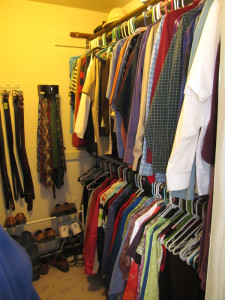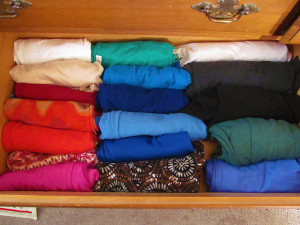10 Easy Steps to Organize Your Closet
 Do you stand in front of your closet every morning trying to figure out what it is you’re going to wear to work today?
Do you stand in front of your closet every morning trying to figure out what it is you’re going to wear to work today?
Do you have a bulging closet but often feel like you just have nothing to wear?
There is a solution and it doesn’t involve maxing out your credit card at the mall.
You need to organize your closet. In an organized closet, you know what you have, you know that it fits you and you know you have many choices for complete outfits. What you don’t have is stress, ill-fitting clothing or trouble finding what you need. Whether it’s your closets, your spouse’s closet or your children’s closets, these simple steps will help you whip those closets into shape in no time at all.
Here’s how:
First, make sure you have a work space, either by making sure your bed and bedroom floor is clear enough for you to remove things from the closet and have a place to put them—and still move around.
Once you’ve done that, remove EVERYTHING from your closet. If you share a closet with someone else, save their stuff for another day. Just remove what belongs to you—this is easier if you aren’t trying to organize two different closets at the same time. As you remove it, sort it by what it is: tops, skirts, jackets, pants, shoes, etc. Next, empty your dresser as well and sort it in the same manner.
Once you’ve emptied the closet, take a few minutes to give it a good cleaning—wipe down the shelves and walls, and sweep or vacuum the floor. I’ll bet it already feels better.
On to the actual organizing.
 Start by getting rid of everything that doesn’t fit. Doesn’t matter whether it’s too big or too small or how much you paid for it–this is a biggie. Too often we keep things because we paid a lot for them. If you can’t use it, it doesn’t matter HOW MUCH you paid for it. Keeping it only compounds the problem and makes you feel worse—why keep reminding yourself of a clothing mistake? If it doesn’t fit you, put it in your “donate” box, put it in your car and immediately drive it to a donation center before you have a chance to talk yourself out of it (as soon as you’re done with this project, of course). I don’t want to hear how you’re going to lose 20 pounds and then it will fit. I don’t know about you, but if I lose 20 pounds, I plan to celebrate with a new wardrobe—not by squeezing back into things that aren’t in style any more.
Start by getting rid of everything that doesn’t fit. Doesn’t matter whether it’s too big or too small or how much you paid for it–this is a biggie. Too often we keep things because we paid a lot for them. If you can’t use it, it doesn’t matter HOW MUCH you paid for it. Keeping it only compounds the problem and makes you feel worse—why keep reminding yourself of a clothing mistake? If it doesn’t fit you, put it in your “donate” box, put it in your car and immediately drive it to a donation center before you have a chance to talk yourself out of it (as soon as you’re done with this project, of course). I don’t want to hear how you’re going to lose 20 pounds and then it will fit. I don’t know about you, but if I lose 20 pounds, I plan to celebrate with a new wardrobe—not by squeezing back into things that aren’t in style any more.
Next, remove anything you know you aren’t going to wear. Yes, we all these in our closet. Dispose of these losers in the same manner.
Now let’s move on to clothing you aren’t wearing because it is in disrepair or needs alterations. Go through it all, determine what the problem is and then decide how you’re going to solve it. If it’s old and worn out, throw it away (caveat: if you regularly do home/car repairs and/or yard work, you can keep one or two outfits specifically for this purpose—but no more than that and only if they are an actual necessity). For clothing that needs repair: are you actually going to repair it—and when? If you aren’t going to do the mending (or have it done) within 30 days, put it in your donate box unless the repair is major and then it goes in the rag bag or garbage. If you are going to commit to the repairs, attach a dated note to each garment with the repair details on it and set them aside. They aren’t going back into the closet. Ditto for any article of clothing that needs alterations. By the way, if you need a tailor or seamstress, you can usually find one at any dry cleaner or shoe repair shop (really!)
Now, if you happen to live in a place where you need a seasonal wardrobe, figure out if it is helpful to you or a hindrance to keep the out-of-season clothing in your closet/dresser. If they’re going back into the closet (or dresser), group them together to keep them out of the way. Otherwise, put them in a labeled garment bag or bin and store them wherever you store seasonal goods.
Now you’re ready to start putting things back.
As you restock your wardrobe, keep like items together—skirts with skirts, jackets with jackets, pants with pants, etc. I also tend to group my items within their groups either by color or style (my long-sleeve button-up shirts hang together, my short-sleeve blouses hang together, etc.). This makes finding what you need and creating outfits much easier.
 To keep your drawers tidy and easily see what you have, I recommend rolling your shirts and sweaters and even your jeans as you put them back. This, keeps them unwrinkled, eliminates the need to pull something from the middle of a stack and makes it easy to see them all at a glance.
To keep your drawers tidy and easily see what you have, I recommend rolling your shirts and sweaters and even your jeans as you put them back. This, keeps them unwrinkled, eliminates the need to pull something from the middle of a stack and makes it easy to see them all at a glance.
Finally, as you are re-hanging your clothes, turn the hangers backward. Each time you wear something, turn the hanger around the right way. In 90 days (excepting those seasonal clothes and a special occasion dress or two), you will easily see what you are and aren’t wearing and you can get rid of everything that’s still hanging backward in your closet.
As for your shoes, if you have more than you can neatly fit in a row on the closet floor, invest in a shoe shelf or rack that will hold two or three times the pairs of shoes in the space you would normally put one. And sort through those shoes in the same way you sort your clothes. Get rid of anything ratty, anything that doesn’t fit and anything you don’t love. Life is much too short to wear bad shoes. Put only the good ones back in your closet.
After sorting, accessories (like belts, scarves and purses) can hang on hooks on the closet wall if you have room. Otherwise, consider rolling belts and scarves and storing them in a bin on the shelf or using a scarf hanger like this one from IKEA. Purses can sit in a row on the shelf or, if you’re lucky enough to have that much closet space (clearly I don’t), you can use s-hooks to hang them.
And now, stand back and admire your handiwork and resolve that you will shop more carefully and thoughtfully in the future.
Or not, in which case you really need to bookmark this post for the next time you need a closet clean-out.








Good tips! I try to clean out my closet a couple of times a year. It really helps to actually be able to see what I have.
I do the same, Lisa. For me, it’s usually at change of seasons when I’m either getting out the winter goods or finally putting them away. Amazing how a little closet organizing can make such a big difference.
Luv these ideas. Here’s one more that I’ve adapted over the years. Take a hanging sweater rack… (these are pretty inexpensive)and place them horizontally on the shelf rather then hanging. You can see all the items by color much easier and it keeps things from falling of the shelf.